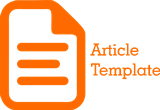Sustainable Development Goals (SDGs) and Indonesian Housing Policy
Abstract
The main objective of the implementation of Sustainable Development Goals (SDGs) in Indonesia is to bring accelerated development in all aspects so that the poverty rate is expected to decrease even disappear. One of the programs that aimed to reduce poverty rates in Indonesia is the provision of housing for the community, especially the underprivileged. Moreover, it is a the million houses program that proclaimed by the Ministry of Public Works and People's Housing, and this program is correlated with the SDGS, especially goal 11 (sustainable cities and communities). The research is relying on secondary data basis primarily from books, journals, published reports and online news. It is expected that this study is able to provide a new insight for the government in building a community residential area, which is to integrate development plans into three dimensions (social, economic, and environment) which are the pillars of sustainable development. Unfortunately, nowadays the government is relying too hard on achieving quantity and a little focus on quality. Furthermore, an experience on the MDGs edition can be an important lesson for the government in realizing SDGs, especially now that SDGs are in line with the points that contained in the RPJMN. Therefore, if the government is able to maximise this global development agenda, it is not impossible that the million houses program can be one of the leading programs in overcoming the problem of poverty, especially housing shortage in Indonesia.
Keywords
Full Text:
PDFReferences
Andrews, L., et al. (2012) Classic Grounded Theory to Analyse Secondary Data: Reality and Reflections. The Grounded Theory Review, Volume 11, pp. 12-26.
Agustian, W. (2015) 33 Million Population Living in Slum Areas. Okezone [Online]. Available from: [Accessed 8 April 2017].
Bappenas. (2015) Development Planning Documents. Bappenas [Online]. Available from: [Accessed 28 March 2017].
Bappenas. (2016) Zero Draft: Technical Guidelines for Sustainable Development Action Plan. The Secretariat of SDGs Indonesia [Online]. Available from: [Accessed 28 March 2017].
Battersby, J. (2017) MDGs to SDGs-new goals, same gaps: the continued absence of urban food security in the post-2015 global development agenda. African Geographical Review, Volume 36 (1), pp.115-129.
Bello, A. and Suleman, A. (2011). The Challenge of Achieving the Millennium Development Goals in IDB Member Countries in the Post-Crisis World. ISDB. [online] Available at: [Accessed 10 April 2017].
Beare, K. (2015) From MDGs to SDGs: What’s Different?. Feelgood [Online]. Available from: [Accessed 28 March 2017].
BPS. (2017) Static Table: Housing Indicators 1993-2017. Badan Pusat Statistik [Online]. Available from: [Accessed 29 March 2017].
Caiserio, E.B. (2016) The Following is the Obstacles of the Million Houses Program. Properti [Online]. Available from: [Accessed 16 April 2017].
Clemens, M. and Moss, T. (2008). What’s Wrong with the Millennium Development Goals. CGDEV. [online] Available at: [Accessed 10 April 2017].
Common, M., and Stagl, S. (2005) Ecological Economics: An Introduction. Cambridge: Cambridge University Press.
Easterly, W. (2008). How the Millennium Development Goals are Unfair to Africa. World Development, 37(1), pp. 26–35.
Fitri, C., and Vonda, P. (2016) How the Commitment to Achieve Sustainable Development Goals Impacts Poor Women in Aceh Province, Indonesia. Gender Equality: International Journal of Child and Gender Studies, Volume 2 (2), pp.51-58.
Golubchikov, O., and Badyina, A. (2012) Sustainable Housing for Sustainable Cities: A Policy Framework for Developing Countries. Nairobi: UN-HABITAT.
Johnston, M.P. (2014). Secondary Data Analysis: A Method that which a Time Has Come. Quantitative and Qualitative Methods in Library (QQML), Volume 3, pp. 619-626.
Kemenpupera. (2016) Ministry PUPR to Build 700,000 Unit Homes for Low-Income Communities in 2016. Kemepupera [Online]. Available from: [Accessed 9 April 2017].
Kumar S. et al. (2016). Millennium Development Goals (MDGs) to Sustainable Development Goals (SDGs): Addressing Unfinished Agenda and Strengthening Sustainable Development and Partnership. Indian J Community Med, Volume 4, pp.1-4.
Lubis, E. and Sinaga, A. (2018) Legal Perspective of Using Philanthropy Approach for Low Income Household in Accessing Sufficient House in Indonesia. Sriwijaya Law Review, volume 2(1), p.93-109.
Mignaqui, V. (2014) Sustainable Development as a Goal: Social, Environmental and Economic Dimensions. International Journal of Social Quality, volume 4(1), 2014, p. 57-77.
Millington, K.A., and Cleland, J. (2017) Counting people and making people count: Implications of future population change for sustainable development, K4D Helpdesk Report. Brighton, UK: Institute of Development Studies.
Pitoko, R.A. (2016) Note, the Indonesian Slum Area More than 38,000 Hectares. Kompas [Online]. Available from: [Accessed 29 March 2017].
Pitoko, R.A. (2017) Basuki Optimists that the Million Houses Program Will Achieved the Target in this Year. Kompas [Online]. Available from: [Accessed 29 March 2017].
Rippin, N. (2013). Progress, Prospects, and Lessons from the MDGs. High-level Panel. [online] Available at: [Accessed 10 April 2017].
Susanti, R. et al. (2016) Smart Growth, Smart City and Density: in Search of the Appropriate Indicator for Residential Density in Indonesia. Procedia-Social and Behavioral Sciences, volume 227, p.194-201
Teferi, Z., and Newman P. (2017) Slum Regeneration and Sustainability: Applying the Extended Metabolism Model and the SDGs. Sustainability, Volume 9, pp.1-16.
Tibaijuka, A.K. (2009) Building Prosperity: Housing and Economic Development. London: Earthscan.
United Nations. (2014) Major Groups and other Stakeholders Morning Hearings: Summary of Statements. United Nations [Online]. Available from: [Accessed 02 January 2018].
United Nations. (2015) Transforming our World: The 2030 Agenda for Sustainable Development. United Nations [Online]. Available from: [Accessed 22 March 2017].
World Bank. (2012) Raskin Subsidized Rice Delivery, Social Assistance Program and Public Expenditure Review 3 [Online]. Available from: [Accessed 1 April 2017].
World Bank. (2016) Indonesia’s Rising Divide [Online]. Available from: [Accessed 10 April 2017].
DOI: https://doi.org/10.26618/ojip.v8i1.760
Refbacks
- There are currently no refbacks.
Copyright (c) 2018 Otoritas : Jurnal Ilmu Pemerintahan

This work is licensed under a Creative Commons Attribution-ShareAlike 4.0 International License.





